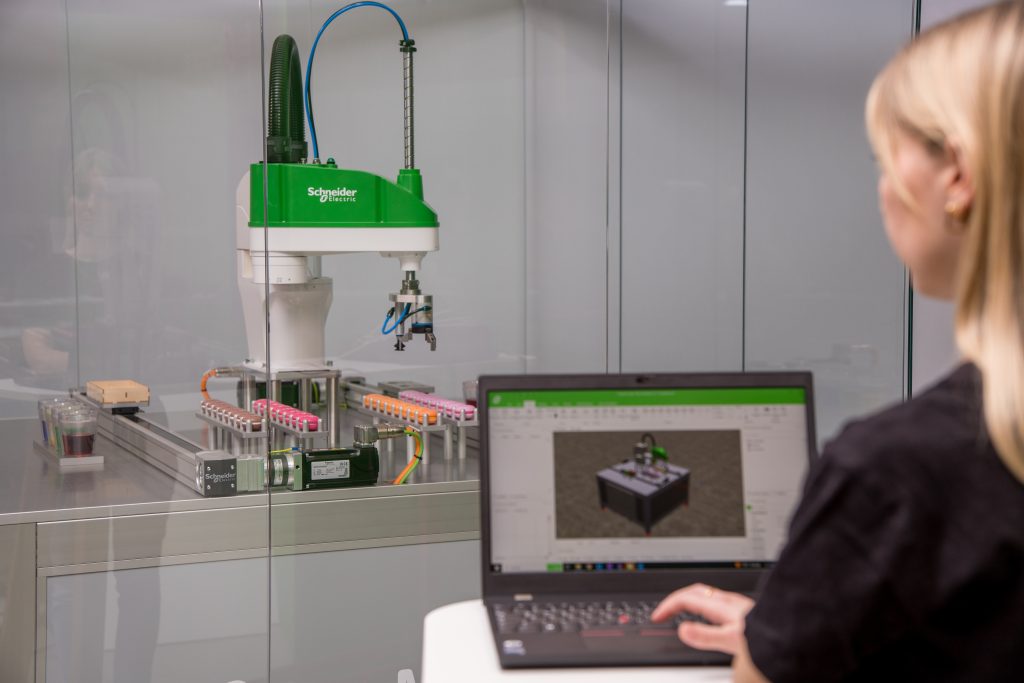A quiet revolution is taking place in the heart of modern manufacturing facilities. Labor shortages, changing market demands, and smart manufacturing are changing facilities’ operations. Enter the Selective Compliance Articulated Robot Arm (SCARA) – a technology reshaping the landscape of industrial automation. With advanced speed, precision, and adaptability, SCARA robots enhance efficiency and innovation in today’s manufacturing and logistics.

Fueled by a perfect storm of technological advancement and industry demand, these small-footprint, cost-effective industrial robots have gained popularity and become indispensable assets across various industrial sectors. In fact, the global SCARA robot market has soared to $8.75 billion in 2022, with projections reaching a staggering $15.25 billion by 2028.
Exponential growth fueled by real-world benefits
SCARA robots are widely used in industries like electronics assembly, battery manufacturing, logistics/warehousing, Food and Beverage, Life Sciences, and machinery for applications, including:
- Assembly
- Pick-and-place – Packaging, sorting, loading/unloading, etc.
- Inspection
- Dispencing and coating
- Welding/soldering
By efficiently and more precisely executing horizontal and vertical movements, SCARA robots enhance productivity by handling repetitive tasks like loading raw materials, transferring components, or packaging products. This helps ensure reliable, consistent, and optimized assembly processes.
SCARA robots are designed for smart manufacturing and significantly address current and future market challenges:
- Workforce shortages: With labor pools shrinking and competition for skilled workers intensifying, the need for automation has never been more urgent. These robots fill these gaps, tackling repetitive tasks efficiently and freeing human workers to focus on complex, higher-value endeavors. They can also offer a safer work environment by performing traditionally dangerous tasks.
- Operational efficiency: Every second counts in an era defined by lean principles and just-in-time production. With unmatched speed, precision, and adaptability, SCARA robots help streamline processes, optimize workflows, maximize output, and meet evolving production demands without sacrificing quality. From material handling to assembly and beyond, these robots are the linchpins of efficiency in forward-thinking factories and serve as catalysts for productivity and growth.
- Smart manufacturing: With Industry 4.0, the role of SCARA robots has become even more pivotal. Engineered for maximum versatility, these robots seamlessly integrate into existing systems to enable data-driven decision-making, which helps minimize downtime and maximize performance. They also promote sustainable manufacturing practices by optimizing energy consumption, reducing waste, and improving energy efficiency. By harnessing the power of integrated automation technology, manufacturers can navigate the complexities of the industrial digital transformation with confidence and agility.
Navigating SCARA selection: Essential factors for success
Multiple factors should be considered when choosing an industrial robot. First, look at the application requirements and operational environment of the robot. Then, consider factors such as design/footprint, payload capacity, reach, speed, precision, ease of programming and integration, and overall cost.
For example, Schneider Electric’s Lexium SCARA robots are an ultra-compact, high-speed solution with built-in controllers and servo drives for precise positioning and complex tracking operations. They integrate into a single machine control system, synchronizing multiple robotic systems while pairing them with a digital twin solution to streamline virtual testing. With a large work area and minimal footprint, they stand out for their efficiency and versatility.
The power of integrated SCARA robots
With its speed, precision, and flexibility, the SCARA robot is vital in industrial automation. However, what differentiates its significance is its seamless integration into a unified machine control system. This integration allows for synchronized operations with other equipment, data exchange, and centralized control, maximizing operational efficiency and adaptability. The SCARA robot’s true value emerges when it becomes integral to a cohesive and interconnected industrial control environment.
Please visit Lexium Scara robot and learn more about integrated robotics.




Add a comment